Nanoimprint Lithography for Next-Generation Carbon Nanotube-Based Devices
Abstract
:1. Introduction
2. Materials and Methods
2.1. Patterning Catalyst System
2.2. Thermal Resists
2.3. Nanoimprint Lithography (NIL)
2.4. Magnetron Sputtering
2.5. Reactive Plasma Etching
2.6. Characterization Tools
2.7. Chemical Vapor Deposition (CVD)
3. Results & Discussion
3.1. Fabrication of Patterned Catalyst System
3.2. NIL Process Parameters and Optimization
3.3. Catalyst Deposition
3.4. Reactive Plasma Etching
3.5. CNT Patterns Grown by CVD
3.6. CNT Characterization
4. Conclusions
Author Contributions
Funding
Data Availability Statement
Conflicts of Interest
References
- Jain, N.; Gupta, E.; Kanu, N.J. Plethora of Carbon Nanotubes Applications in Various Fields—A State-of-the-Art-Review. Smart Sci. 2022, 10, 1–24. [Google Scholar] [CrossRef]
- Norizan, M.N.; Moklis, M.H.; Ngah Demon, S.Z.; Halim, N.A.; Samsuri, A.; Mohamad, I.S.; Knight, V.F.; Abdullah, N. Carbon Nanotubes: Functionalisation and Their Application in Chemical Sensors. RSC Adv. 2020, 10, 43704–43732. [Google Scholar] [CrossRef]
- Wu, X.; Mu, F.; Zhao, H. Recent Progress in the Synthesis of Graphene/CNT Composites and the Energy-Related Applications. J. Mater. Sci. Technol. 2020, 55, 16–34. [Google Scholar] [CrossRef]
- Singh, K.; Khanna, V.; Sonu; Singh, S.; Bansal, S.A.; Chaudhary, V.; Khosla, A. Paradigm of State-of-the-Art CNT Reinforced Copper Metal Matrix Composites: Processing, Characterizations, and Applications. J. Mater. Res. Technol. 2023, 24, 8572–8605. [Google Scholar] [CrossRef]
- Pandey, P.; Dahiya, M. Carbon Nanotubes: Types, Methods of Preparation and Applications. Carbon 2016, 1, 15–21. [Google Scholar]
- Abdalla, S.; Al-Marzouki, F.; Al-Ghamdi, A.A.; Abdel-Daiem, A. Different Technical Applications of Carbon Nanotubes. Nanoscale Res. Lett. 2015, 10, 358. [Google Scholar] [CrossRef] [PubMed]
- Anzar, N.; Hasan, R.; Tyagi, M.; Yadav, N.; Narang, J. Carbon Nanotube—A Review on Synthesis, Properties and Plethora of Applications in the Field of Biomedical Science. Sens. Int. 2020, 1, 100003. [Google Scholar] [CrossRef]
- Akter, T.; Desai, S. Developing a Predictive Model for Nanoimprint Lithography Using Artificial Neural Networks. Mater. Des. 2018, 160, 836–848. [Google Scholar] [CrossRef]
- Nandipati, M.; Fatoki, O.; Desai, S. Bridging Nanomanufacturing and Artificial Intelligence—A Comprehensive Review. Materials 2024, 17, 1621. [Google Scholar] [CrossRef] [PubMed]
- Yun, Y.-H.; Shanov, V.; Schulz, M.J.; Narasimhadevara, S.; Subramaniam, S.; Hurd, D.; Boerio, F.J. Development of Novel Single-Wall Carbon Nanotube–Epoxy Composite Ply Actuators. Smart Mater. Struct. 2005, 14, 1526–1532. [Google Scholar] [CrossRef]
- Smail, F.; Boies, A.; Windle, A. Direct Spinning of CNT Fibres: Past, Present and Future Scale Up. Carbon 2019, 152, 218–232. [Google Scholar] [CrossRef]
- Xiang, R.; Luo, G.; Yang, Z.; Zhang, Q.; Qian, W.; Wei, F. Large Area Growth of Aligned CNT Arrays on Spheres: Cost Performance and Product Control. Mater. Lett. 2009, 63, 84–87. [Google Scholar] [CrossRef]
- Soni, S.K.; Thomas, B.; Kar, V.R. A Comprehensive Review on CNTs and CNT-Reinforced Composites: Syntheses, Characteristics and Applications. Mater. Today Commun. 2020, 25, 101546. [Google Scholar] [CrossRef]
- Olawore, O.; Ogunmola, M.; Desai, S. Engineered Nanomaterial Coatings for Food Packaging: Design, Manufacturing, Regulatory, and Sustainability Implications. Micromachines 2024, 15, 245. [Google Scholar] [CrossRef]
- Yun, Y.; Dong, Z.; Shanov, V.N.; Schulz, M.J. Electrochemical Impedance Measurement of Prostate Cancer Cells Using Carbon Nanotube Array Electrodes in a Microfluidic Channel. Nanotechnology 2007, 18, 465505. [Google Scholar] [CrossRef]
- Chazot, C.A.C.; Hart, A.J. Understanding and Control of Interactions between Carbon Nanotubes and Polymers for Manufacturing of High-Performance Composite Materials. Compos. Sci. Technol. 2019, 183, 107795. [Google Scholar] [CrossRef]
- Wei, B.Q.; Vajtai, R.; Jung, Y.; Ward, J.; Zhang, R.; Ramanath, G.; Ajayan, P.M. Organized Assembly of Carbon Nanotubes. Nature 2002, 416, 495–496. [Google Scholar] [CrossRef] [PubMed]
- Li, J.; Pandey, G.P. Advanced Physical Chemistry of Carbon Nanotubes. Annu. Rev. Phys. Chem. 2015, 66, 331–356. [Google Scholar] [CrossRef] [PubMed]
- Yun, Y.; Shanov, V.; Schulz, M.J.; Dong, Z.; Jazieh, A.; Heineman, W.R.; Halsall, H.B.; Wong, D.K.Y.; Bange, A.; Tu, Y.; et al. High Sensitivity Carbon Nanotube Tower Electrodes. Sens. Actuators B Chem. 2006, 120, 298–304. [Google Scholar] [CrossRef]
- Inoue, Y.; Hayashi, K.; Karita, M.; Nakano, T.; Shimamura, Y.; Shirasu, K.; Yamamoto, G.; Hashida, T. Study on the Mechanical and Electrical Properties of Twisted CNT Yarns Fabricated from CNTs with Various Diameters. Carbon 2021, 176, 400–410. [Google Scholar] [CrossRef]
- Ghemes, A.; Minami, Y.; Muramatsu, J.; Okada, M.; Mimura, H.; Inoue, Y. Fabrication and Mechanical Properties of Carbon Nanotube Yarns Spun from Ultra-Long Multi-Walled Carbon Nanotube Arrays. Carbon 2012, 50, 4579–4587. [Google Scholar] [CrossRef]
- Sugano, K.; Kurata, M.; Kawada, H. Evaluation of Mechanical Properties of Untwisted Carbon Nanotube Yarn for Application to Composite Materials. Carbon 2014, 78, 356–365. [Google Scholar] [CrossRef]
- Liang, X.; Li, H.; Dou, J.; Wang, Q.; He, W.; Wang, C.; Li, D.; Lin, J.; Zhang, Y. Stable and Biocompatible Carbon Nanotube Ink Mediated by Silk Protein for Printed Electronics. Adv. Mater. 2020, 32, 2000165. [Google Scholar] [CrossRef]
- Tang, J. Carbon Nanotube-Based Flexible Electronics. In Flexible, Wearable, and Stretchable Electronics, 1st ed.; Iniewski, K., Ed.; Series: Devices, Circuits, & Systems; CRC Press: Boca Raton, FL, USA, 2020; pp. 137–156. ISBN 978-0-429-26394-1. [Google Scholar]
- Zhang, X.; Lu, W.; Zhou, G.; Li, Q. Understanding the Mechanical and Conductive Properties of Carbon Nanotube Fibers for Smart Electronics. Adv. Mater. 2020, 32, 1902028. [Google Scholar] [CrossRef] [PubMed]
- Wong, H.-S.P.; Mitra, S.; Akinwande, D.; Beasley, C.; Chai, Y.; Chen, H.-Y.; Chen, X.; Close, G.; Deng, J.; Hazeghi, A.; et al. Carbon Nanotube Electronics—Materials, Devices, Circuits, Design, Modeling, and Performance Projection. In Proceedings of the 2011 International Electron Devices Meeting, Washington, DC, USA, 5–7 December 2011; IEEE: Piscataway, NJ, USA; pp. 23.1.1–23.1.4. [Google Scholar]
- Peng, L.-M.; Zhang, Z.; Qiu, C. Carbon Nanotube Digital Electronics. Nat. Electron. 2019, 2, 499–505. [Google Scholar] [CrossRef]
- Yun, Y.; Shanov, V.; Tu, Y.; Schulz, M.J.; Yarmolenko, S.; Neralla, S.; Sankar, J.; Subramaniam, S. A Multi-Wall Carbon Nanotube Tower Electrochemical Actuator. Nano Lett. 2006, 6, 689–693. [Google Scholar] [CrossRef]
- Yin, L.; Liu, H.; Ding, Y.; Lan, H.; Lu, B. Fabrication of Carbon Nanotube Arrays for Field Emission and Sensor Devices by Nanoimprint Lithography. Microelectron. J. 2009, 40, 604–607. [Google Scholar] [CrossRef]
- Tawfick, S.; Zhao, Z.; Maschmann, M.; Brieland-Shoultz, A.; De Volder, M.; Baur, J.W.; Lu, W.; Hart, A.J. Mechanics of Capillary Forming of Aligned Carbon Nanotube Assemblies. Langmuir 2013, 29, 5190–5198. [Google Scholar] [CrossRef] [PubMed]
- Tawfick, S.; De Volder, M.; Copic, D.; Park, S.J.; Oliver, C.R.; Polsen, E.S.; Roberts, M.J.; Hart, A.J. Engineering of Micro- and Nanostructured Surfaces with Anisotropic Geometries and Properties. Adv. Mater. 2012, 24, 1628–1674. [Google Scholar] [CrossRef]
- Kim, Y.-S.; Lee, K.; Lee, J.S.; Jung, G.Y.; Kim, W.B. Nanoimprint Lithography Patterns with a Vertically Aligned Nanoscale Tubular Carbon Structure. Nanotechnology 2008, 19, 365305. [Google Scholar] [CrossRef]
- Unno, N.; Mäkelä, T. Thermal Nanoimprint Lithography—A Review of the Process, Mold Fabrication, and Material. Nanomaterials 2023, 13, 2031. [Google Scholar] [CrossRef]
- Maruyama, N.; Sato, K.; Suzaki, Y.; Jimbo, S.; Yamashita, I.; Yamamoto, K.; Yamamoto, K.; Hiura, M.; Takabayashi, Y. Advances and Applications in Nanoimprint Lithography. In Proceedings of the Novel Patterning Technologies 2023, San Jose, CA, USA, 1 May 2023; Liddle, J.A., Ruiz, R., Eds.; SPIE: Bellingham, WA, USA; p. 18. [Google Scholar]
- Choi, H.; Kim, J.; Kim, W.; Seong, J.; Park, C.; Choi, M.; Kim, N.; Ha, J.; Qiu, C.-W.; Rho, J.; et al. Realization of High Aspect Ratio Metalenses by Facile Nanoimprint Lithography Using Water-Soluble Stamps. PhotoniX 2023, 4, 18. [Google Scholar] [CrossRef]
- Hager, A.; Güniat, L.; Morgan, N.; Ramanandan, S.P.; Rudra, A.; Piazza, V.; Fontcuberta I Morral, A.; Dede, D. The Implementation of Thermal and UV Nanoimprint Lithography for Selective Area Epitaxy. Nanotechnology 2023, 34, 445301. [Google Scholar] [CrossRef]
- Rodrigues, J.; Desai, S. The Nanoscale Leidenfrost Effect. Nanoscale 2019, 11, 12139–12151. [Google Scholar] [CrossRef] [PubMed]
- Gaikwad, A.; Olowe, M.; Desai, S. Deformation Mechanism of Aluminum, Copper, and Gold in Nanoimprint Lithography Using Molecular Dynamics Simulation. Nanomaterials 2023, 13, 3104. [Google Scholar] [CrossRef] [PubMed]
- Gaikwad, A.; Desai, S. Molecular Dynamics Investigation of the Deformation Mechanism of Gold with Variations in Mold Profiles during Nanoimprinting. Materials 2021, 14, 2548. [Google Scholar] [CrossRef]
- Odujole, J.; Desai, S. Atomistic Investigation of Material Deformation Behavior of Polystyrene in Nanoimprint Lithography. Surfaces 2020, 3, 649–663. [Google Scholar] [CrossRef]
- Gaikwad, A.; Odujole, J.; Desai, S. Atomistic Investigation of Process Parameter Variations on Material Deformation Behavior in Nanoimprint Lithography of Gold. Precis. Eng. 2020, 64, 7–19. [Google Scholar] [CrossRef]
- Odujole, J.I.; Desai, S. Molecular Dynamics Investigation of Material Deformation Behavior of PMMA in Nanoimprint Lithography. AIP Adv. 2020, 10, 095102. [Google Scholar] [CrossRef]
- Parupelli, S.K.; Desai, S. The 3D Printing of Nanocomposites for Wearable Biosensors: Recent Advances, Challenges, and Prospects. Bioengineering 2023, 11, 32. [Google Scholar] [CrossRef]
- Ferrier, D.C.; Honeychurch, K.C. Carbon Nanotube (CNT)-Based Biosensors. Biosensors 2021, 11, 486. [Google Scholar] [CrossRef]
- Pundir, M.; Prasher, P.; Vasić, K.; Leitgeb, M.; Kumar, A.; Prakash, R.; Knez, Ž.; Pandey, J.K.; Kumar, S. Enzyme Modified CNTs for Biosensing Application: Opportunities and Challenges. Colloid Interface Sci. Commun. 2021, 44, 100506. [Google Scholar] [CrossRef]
- Amenta, V.; Aschberger, K. Carbon Nanotubes: Potential Medical Applications and Safety Concerns. WIREs Nanomed. Nanobiotechnol. 2015, 7, 371–386. [Google Scholar] [CrossRef] [PubMed]
- Meng, J.; Hu, X.; Wen, T.; Wang, T.; Liu, J.; Xu, H. Interactions to Plasm Protein and Application Potentials of Carbon Nanotubes in Blood-Contacting Medical Devices. Nano Res. 2023, 16, 12506–12515. [Google Scholar] [CrossRef]
- Streicher, R. Carbon Nanotubes: Applications for Medical Devices. In Carbon Nanotubes; Jenny Stanford Publishing: Dubai, United Arab Emirates, 2019; pp. 61–104. [Google Scholar]
- Saraireh, S.A.; Tarawneh, M.A.; Chen, R.S.; Alsobhi, B.O.; Shahdan, D.; Gan, S.; Moosavi, S. Chemical Properties of Carbon Nanotubes. In Graphene, Nanotubes and Quantum Dots-Based Nanotechnology; Elsevier: Amsterdam, The Netherlands, 2022; pp. 281–304. ISBN 978-0-323-85457-3. [Google Scholar]
- Murjani, B.O.; Kadu, P.S.; Bansod, M.; Vaidya, S.S.; Yadav, M.D. Carbon Nanotubes in Biomedical Applications: Current Status, Promises, and Challenges. Carbon Lett. 2022, 32, 1207–1226. [Google Scholar] [CrossRef]
- Rajakumar, G.; Zhang, X.-H.; Gomathi, T.; Wang, S.-F.; Azam Ansari, M.; Mydhili, G.; Nirmala, G.; Alzohairy, M.A.; Chung, I.-M. Current Use of Carbon-Based Materials for Biomedical Applications—A Prospective and Review. Processes 2020, 8, 355. [Google Scholar] [CrossRef]
- Yan, J.S.; Orecchioni, M.; Vitale, F.; Coco, J.A.; Duret, G.; Antonucci, S.; Pamulapati, S.S.; Taylor, L.W.; Dewey, O.S.; Di Sante, M.; et al. Biocompatibility Studies of Macroscopic Fibers Made from Carbon Nanotubes: Implications for Carbon Nanotube Macrostructures in Biomedical Applications. Carbon 2021, 173, 462–476. [Google Scholar] [CrossRef]
- Riley, P.R.; Narayan, R.J. Recent Advances in Carbon Nanomaterials for Biomedical Applications: A Review. Curr. Opin. Biomed. Eng. 2021, 17, 100262. [Google Scholar] [CrossRef]
- Pumera, M.; Sánchez, S.; Ichinose, I.; Tang, J. Electrochemical Nanobiosensors. Sens. Actuators B Chem. 2007, 123, 1195–1205. [Google Scholar] [CrossRef]
- Minot, E.D.; Janssens, A.M.; Heller, I.; Heering, H.A.; Dekker, C.; Lemay, S.G. Carbon Nanotube Biosensors: The Critical Role of the Reference Electrode. Appl. Phys. Lett. 2007, 91, 093507. [Google Scholar] [CrossRef]
- Allen, B.L.; Kichambare, P.D.; Star, A. Carbon Nanotube Field-Effect-Transistor-Based Biosensors. Adv. Mater. 2007, 19, 1439–1451. [Google Scholar] [CrossRef]
- Muguruma, H.; Kase, Y. Structure and Biosensor Characteristics of Complex between Glucose Oxidase and Plasma-Polymerized Nanothin Film. Biosens. Bioelectron. 2006, 22, 737–743. [Google Scholar] [CrossRef] [PubMed]
- Choong, C.-L.; Bendall, J.S.; Milne, W.I. Carbon Nanotube Array: A New MIP Platform. Biosens. Bioelectron. 2009, 25, 652–656. [Google Scholar] [CrossRef] [PubMed]
- Gao, M.; Dai, L.; Wallace, G.G. Biosensors Based on Aligned Carbon Nanotubes Coated with Inherently Conducting Polymers. Electroanalysis 2003, 15, 1089–1094. [Google Scholar] [CrossRef]
- Jing, C.; Jian-Chun, B.; Chen-Xin, C. Fabrication, Characterization and Electrocatalysis of an Ordered Carbon Nanotube Electrode. Chin. J. Chem. 2003, 21, 665–669. [Google Scholar] [CrossRef]
- Trojanowicz, M. Analytical Applications of Carbon Nanotubes: A Review. TrAC Trends Anal. Chem. 2006, 25, 480–489. [Google Scholar] [CrossRef]
- Arribas, A.S.; Bermejo, E.; Chicharro, M.; Zapardiel, A.; Luque, G.L.; Ferreyra, N.F.; Rivas, G.A. Analytical Applications of a Carbon Nanotubes Composite Modified with Copper Microparticles as Detector in Flow Systems. Anal. Chim. Acta 2006, 577, 183–189. [Google Scholar] [CrossRef]
- Yamazoe, N. Toward Innovations of Gas Sensor Technology. Sens. Actuators B Chem. 2005, 108, 2–14. [Google Scholar] [CrossRef]
- De Volder, M.F.L.; Tawfick, S.H.; Baughman, R.H.; Hart, A.J. Carbon Nanotubes: Present and Future Commercial Applications. Science 2013, 339, 535–539. [Google Scholar] [CrossRef] [PubMed]
- Aslam, M.M.-A.; Kuo, H.-W.; Den, W.; Usman, M.; Sultan, M.; Ashraf, H. Functionalized Carbon Nanotubes (CNTs) for Water and Wastewater Treatment: Preparation to Application. Sustainability 2021, 13, 5717. [Google Scholar] [CrossRef]
- Arora, B.; Attri, P. Carbon Nanotubes (CNTs): A Potential Nanomaterial for Water Purification. J. Compos. Sci. 2020, 4, 135. [Google Scholar] [CrossRef]
- Peng, J.; He, Y.; Zhou, C.; Su, S.; Lai, B. The Carbon Nanotubes-Based Materials and Their Applications for Organic Pollutant Removal: A Critical Review. Chin. Chem. Lett. 2021, 32, 1626–1636. [Google Scholar] [CrossRef]
- Yu, C.-C.; Chen, H.-L. Nanoimprint Technology for Patterning Functional Materials and Its Applications. Microelectron. Eng. 2015, 132, 98–119. [Google Scholar] [CrossRef]
- Corletto, A.; Shapter, J.G. Nanoscale Patterning of Carbon Nanotubes: Techniques, Applications, and Future. Adv. Sci. 2021, 8, 2001778. [Google Scholar] [CrossRef] [PubMed]
- Ofir, Y.; Moran, I.W.; Subramani, C.; Carter, K.R.; Rotello, V.M. Nanoimprint Lithography for Functional Three-Dimensional Patterns. Adv. Mater. 2010, 22, 3608–3614. [Google Scholar] [CrossRef]
- Venkataraman, A.; Amadi, E.V.; Chen, Y.; Papadopoulos, C. Carbon Nanotube Assembly and Integration for Applications. Nanoscale Res. Lett. 2019, 14, 220. [Google Scholar] [CrossRef]
- Kumar, S.; Nehra, M.; Kedia, D.; Dilbaghi, N.; Tankeshwar, K.; Kim, K.-H. Carbon Nanotubes: A Potential Material for Energy Conversion and Storage. Prog. Energy Combust. Sci. 2018, 64, 219–253. [Google Scholar] [CrossRef]
- Lee, Y.T.; Shanmugan, S.; Mutharasu, D. Thermal Resistance of CNTs-Based Thermal Interface Material for High Power Solid State Device Packages. Appl. Phys. A 2014, 114, 1145–1152. [Google Scholar] [CrossRef]
- Mathew, P.T.; Fang, F. Advances in Molecular Electronics: A Brief Review. Engineering 2018, 4, 760–771. [Google Scholar] [CrossRef]
- Nurazzi, N.M.; Sabaruddin, F.A.; Harussani, M.M.; Kamarudin, S.H.; Rayung, M.; Asyraf, M.R.M.; Aisyah, H.A.; Norrrahim, M.N.F.; Ilyas, R.A.; Abdullah, N.; et al. Mechanical Performance and Applications of CNTs Reinforced Polymer Composites—A Review. Nanomaterials 2021, 11, 2186. [Google Scholar] [CrossRef]
- Park, S.; Kang, Y.J.; Majd, S. A Review of Patterned Organic Bioelectronic Materials and Their Biomedical Applications. Adv. Mater. 2015, 27, 7583–7619. [Google Scholar] [CrossRef] [PubMed]
- Esteves, L.M.; Oliveira, H.A.; Passos, F.B. Carbon Nanotubes as Catalyst Support in Chemical Vapor Deposition Reaction: A Review. J. Ind. Eng. Chem. 2018, 65, 1–12. [Google Scholar] [CrossRef]
- Fialkova, S. Application of Nano-Imprint Lithography for Next Generation Carbon Nanotube-Based Devices. Ph.D. Thesis, North Carolina Agricultural and Technical State University, Greensboro, NC, USA, 2013. [Google Scholar]
- Ying, A.J.; Murray, C.E.; Noyan, I.C. A Rigorous Comparison of X-Ray Diffraction Thickness Measurement Techniques Using Silicon-on-Insulator Thin Films. J. Appl. Crystallogr. 2009, 42, 401–410. [Google Scholar] [CrossRef]
- Yasaka, M. X-ray Thin-Film Measurement Techniques. Rigaku J. 2010, 26, 1–9. [Google Scholar]
- Diaz, M.C.; Jiang, H.; Kauppinen, E.; Sharma, R.; Balbuena, P.B. Can Single-Walled Carbon Nanotube Diameter Be Defined by Catalyst Particle Diameter? J. Phys. Chem. C 2019, 123, 30305–30317. [Google Scholar] [CrossRef]
- Radhakrishnan, J.K.; Pandian, P.S.; Padaki, V.C.; Bhusan, H.; Rao, K.U.B.; Xie, J.; Abraham, J.K.; Varadan, V.K. Growth of Multiwalled Carbon Nanotube Arrays by Chemical Vapour Deposition over Iron Catalyst and the Effect of Growth Parameters. Appl. Surf. Sci. 2009, 255, 6325–6334. [Google Scholar] [CrossRef]
- Hartney, M.A.; Greene, W.M.; Soane, D.S.; Hess, D.W. Mechanistic Studies of Oxygen Plasma Etching. J. Vac. Sci. Technol. B Microelectron. Process. Phenom. 1988, 6, 1892–1895. [Google Scholar] [CrossRef]
- Yeh, W.-M.; Noga, D.E.; Lawson, R.A.; Tolbert, L.M.; Henderson, C.L. Comparison of Positive Tone versus Negative Tone Resist Pattern Collapse Behavior. J. Vac. Sci. Technol. B Nanotechnol. Microelectron. Mater. Process. Meas. Phenom. 2010, 28, C6S6–C6S11. [Google Scholar] [CrossRef]
- Foldvari, M.; Lamprecht, C.; Loureiro, M.J.; Huzil, J.T.; Foldvari, M. Pharmaceutical Characterization of Solid and Dispersed Carbon Nanotubes as Nanoexcipients. Int. J. Nanomed. 2012, 7, 403–415. [Google Scholar] [CrossRef] [PubMed]
- Martín, N.; Eaton, M.; Moreno-Da Silva, S.; Naranjo, A.; Perez, E. Automated Statistical Analysis of Raman Spectra of Nanomaterials. Nanoscale 2024, 16, 2048–2059. [Google Scholar] [CrossRef]
- Kwon, O.-S.; Kim, H.; Ko, H.; Lee, J.; Lee, B.; Jung, C.-H.; Choi, J.-H.; Shin, K. Fabrication and Characterization of Inkjet-Printed Carbon Nanotube Electrode Patterns on Paper. Carbon 2013, 58, 116–127. [Google Scholar] [CrossRef]
- Kuzubasoglu, B.A.; Sayar, E.; Bahadir, S.K. Inkjet-Printed CNT/PEDOT:PSS Temperature Sensor on a Textile Substrate for Wearable Intelligent Systems. IEEE Sens. J. 2021, 21, 13090–13097. [Google Scholar] [CrossRef]
- Mass, M.; Veiga, L.S.; Garate, O.; Longinotti, G.; Moya, A.; Ramón, E.; Villa, R.; Ybarra, G.; Gabriel, G. Fully Inkjet-Printed Biosensors Fabricated with a Highly Stable Ink Based on Carbon Nanotubes and Enzyme-Functionalized Nanoparticles. Nanomaterials 2021, 11, 1645. [Google Scholar] [CrossRef]
- Tang, X.; Wu, K.; Qi, X.; Kwon, H.; Wang, R.; Li, Z.; Ye, H.; Hong, J.; Choi, H.H.; Kong, H.; et al. Screen Printing of Silver and Carbon Nanotube Composite Inks for Flexible and Reliable Organic Integrated Devices. ACS Appl. Nano Mater. 2022, 5, 4801–4811. [Google Scholar] [CrossRef]
- Musa, A.; Kiely, J.; Luxton, R.; Honeychurch, K. An Electrochemical Screen-Printed Sensor Based on Gold-Nanoparticle-Decorated Reduced Graphene Oxide–Carbon Nanotubes Composites for the Determination of 17-β Estradiol. Biosensors 2023, 13, 491. [Google Scholar] [CrossRef]
- Silva, R.M.; Da Silva, A.D.; Camargo, J.R.; De Castro, B.S.; Meireles, L.M.; Silva, P.S.; Janegitz, B.C.; Silva, T.A. Carbon Nanomaterials-Based Screen-Printed Electrodes for Sensing Applications. Biosensors 2023, 13, 453. [Google Scholar] [CrossRef] [PubMed]
- Homenick, C.M.; James, R.; Lopinski, G.P.; Dunford, J.; Sun, J.; Park, H.; Jung, Y.; Cho, G.; Malenfant, P.R.L. Fully Printed and Encapsulated SWCNT-Based Thin Film Transistors via a Combination of R2R Gravure and Inkjet Printing. ACS Appl. Mater. Interfaces 2016, 8, 27900–27910. [Google Scholar] [CrossRef]
- Béduer, A.; Seichepine, F.; Flahaut, E.; Vieu, C. A Simple and Versatile Micro Contact Printing Method for Generating Carbon Nanotubes Patterns on Various Substrates. Microelectron. Eng. 2012, 97, 301–305. [Google Scholar] [CrossRef]
- Gubanov, K.; Johnson, M.; Akay, M.; Wolz, B.C.; Shen, D.; Cheng, X.; Christiansen, S.; Fink, R.H. C8-BTBT-C8 Thin-Film Transistors Based on Micro-Contact Printed PEDOT:PSS/MWCNT Electrodes. Adv. Electron. Mater. 2023, 9, 2201233. [Google Scholar] [CrossRef]
- Sakorikar, T.; Mihaliak, N.; Krisnadi, F.; Ma, J.; Kim, T.; Kong, M.; Awartani, O.; Dickey, M.D. A Guide to Printed Stretchable Conductors. Chem. Rev. 2024, 124, 860–888. [Google Scholar] [CrossRef]
- Casimirius, S. Microcontact Printing Process for the Patterned Growth of Individual CNTs. Microelectron. Eng. 2004, 73–74, 564–569. [Google Scholar] [CrossRef]
- Chatzikomis, C.; Pattinson, S.W.; Koziol, K.K.K.; Hutchings, I.M. Patterning of Carbon Nanotube Structures by Inkjet Printing of Catalyst. J. Mater. Sci. 2012, 47, 5760–5765. [Google Scholar] [CrossRef]
- Carpena-Núñez, J.; Davis, B.; Islam, A.E.; Brown, J.; Sargent, G.; Murphy, N.; Back, T.; Maschmann, M.R.; Maruyama, B. Water-Assisted, Electron-Beam Induced Activation of Carbon Nanotube Catalyst Supports for Mask-Less, Resist-Free Patterning. Carbon 2018, 135, 270–277. [Google Scholar] [CrossRef]
- Chen, Y.; Chen, H.; Yu, J.; Williams, J.S.; Craig, V. Focused Ion Beam Milling as a Universal Template Technique for Patterned Growth of Carbon Nanotubes. Appl. Phys. Lett. 2007, 90, 093126. [Google Scholar] [CrossRef]
- Balla, T.; Spearing, S.M.; Monk, A. An Assessment of the Process Capabilities of Nanoimprint Lithography. J. Phys. D Appl. Phys. 2008, 41, 174001. [Google Scholar] [CrossRef]
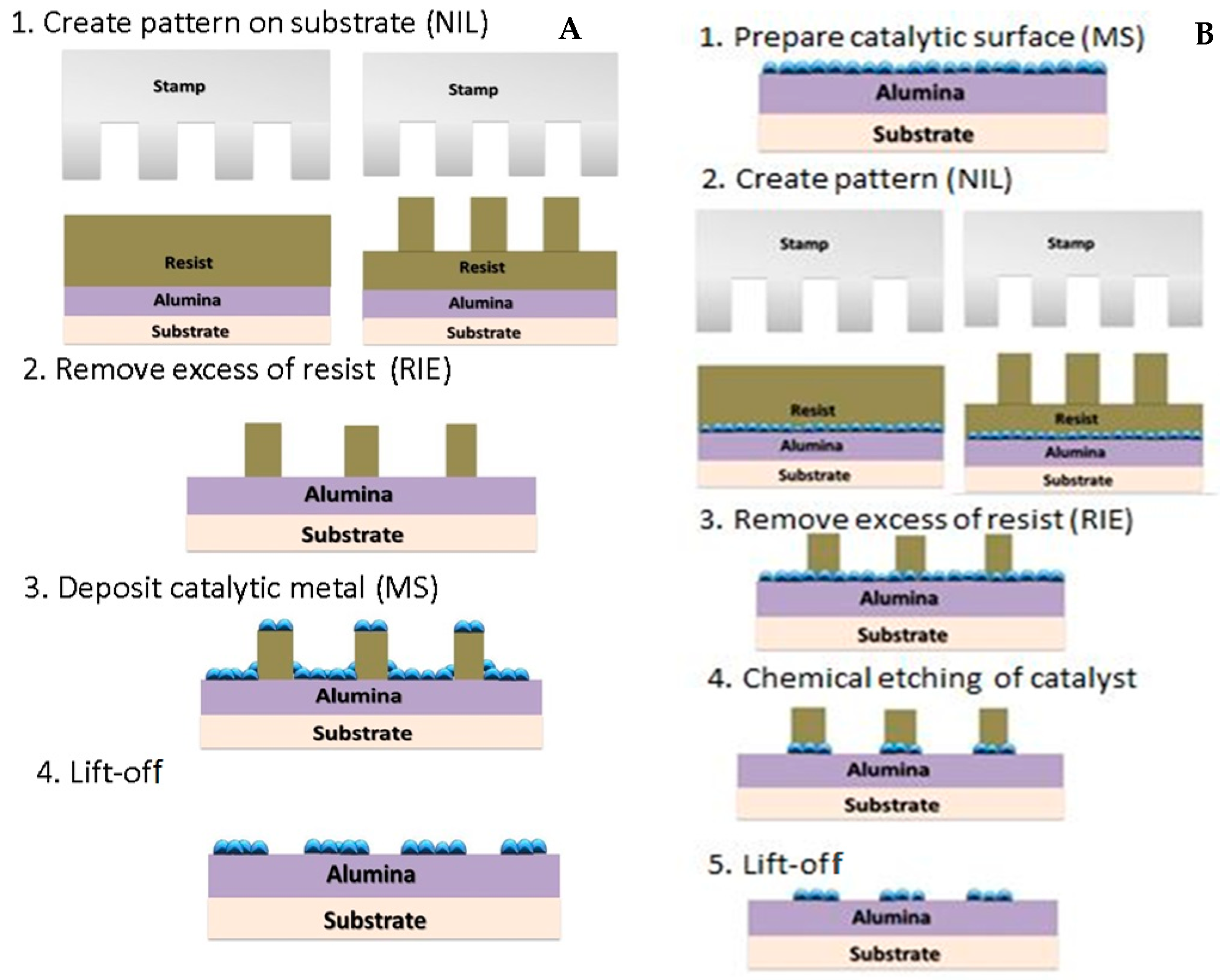
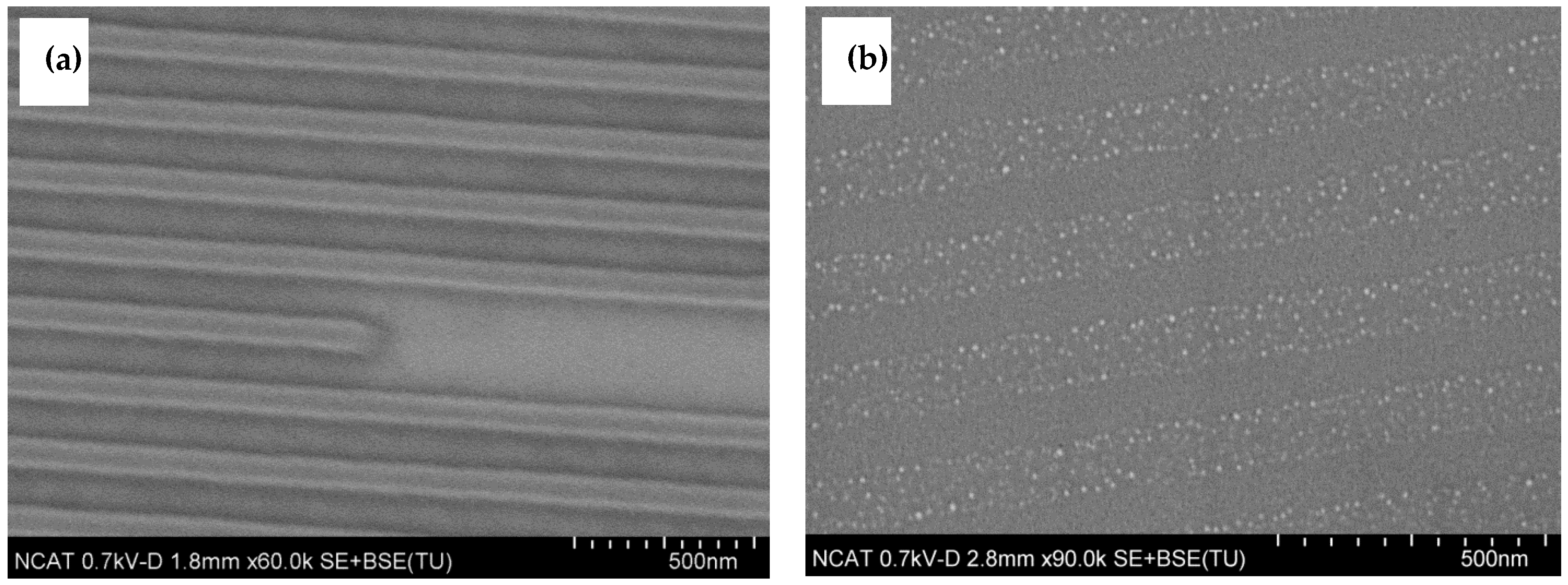
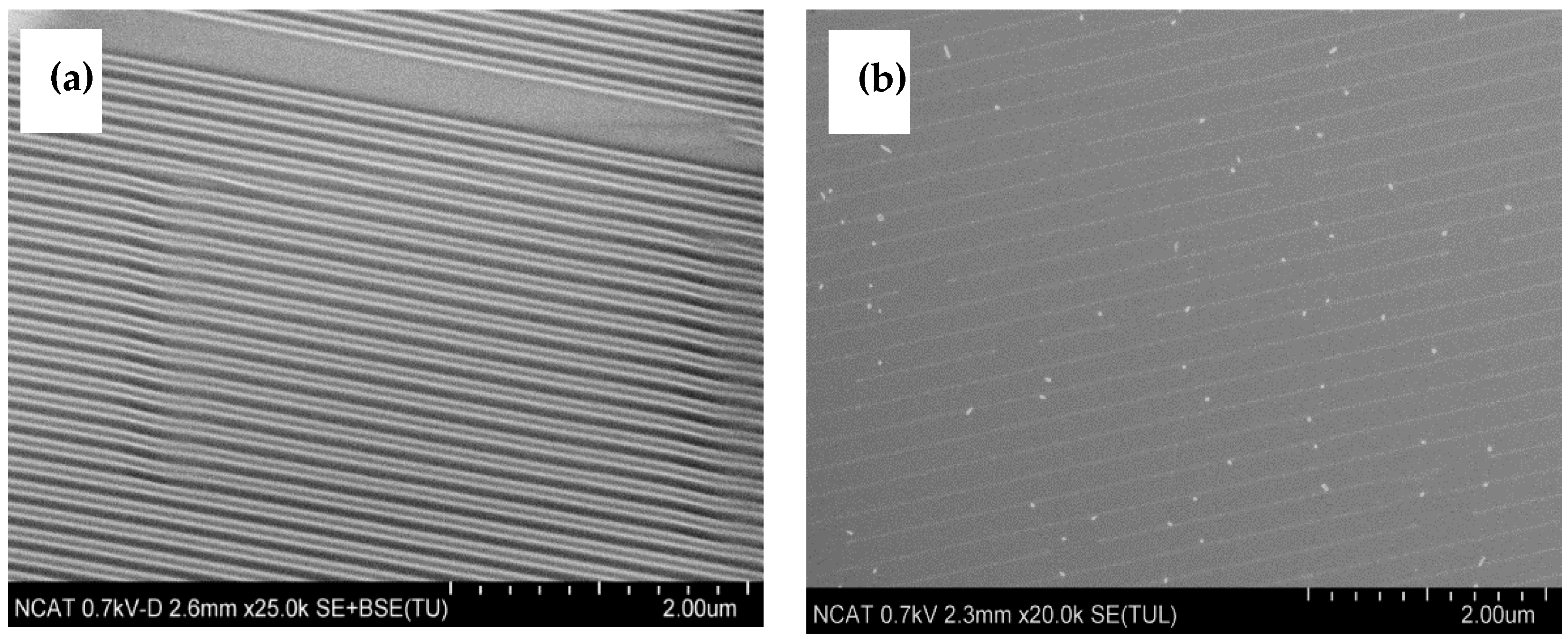
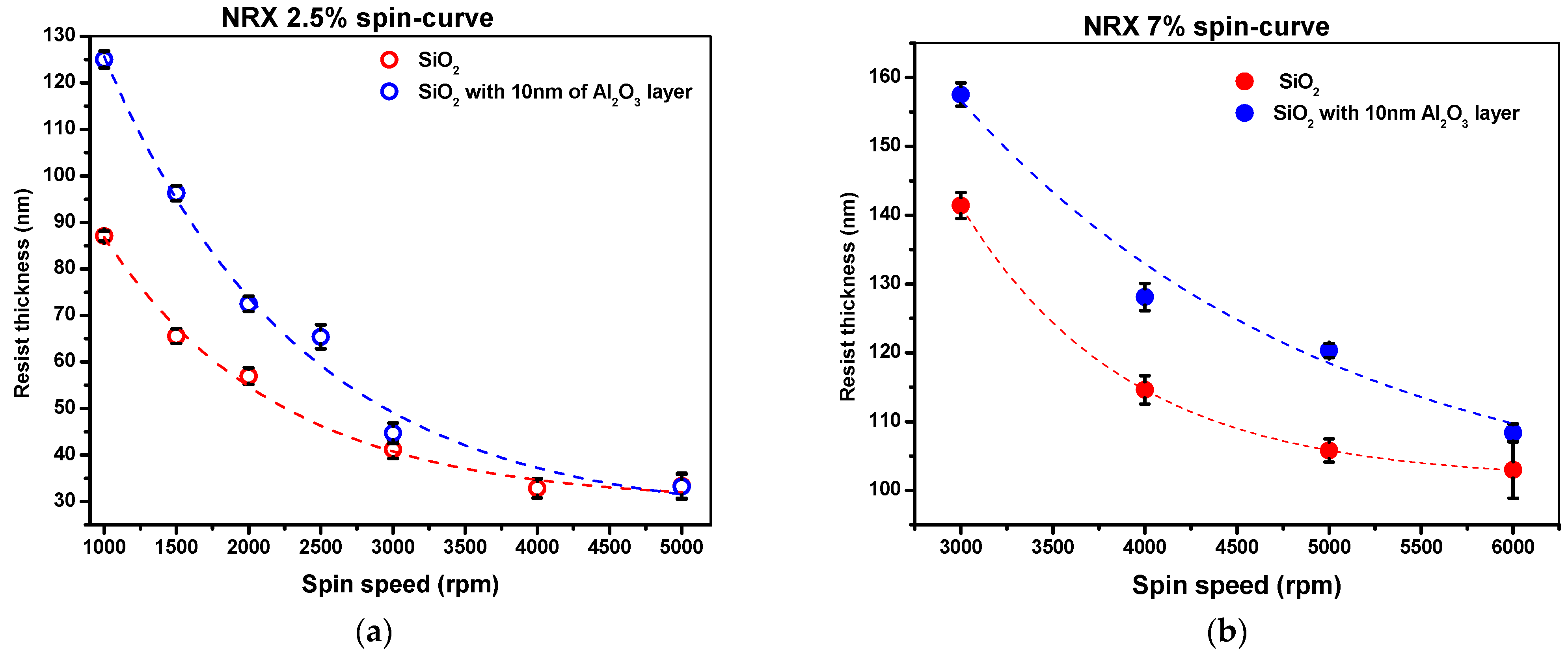
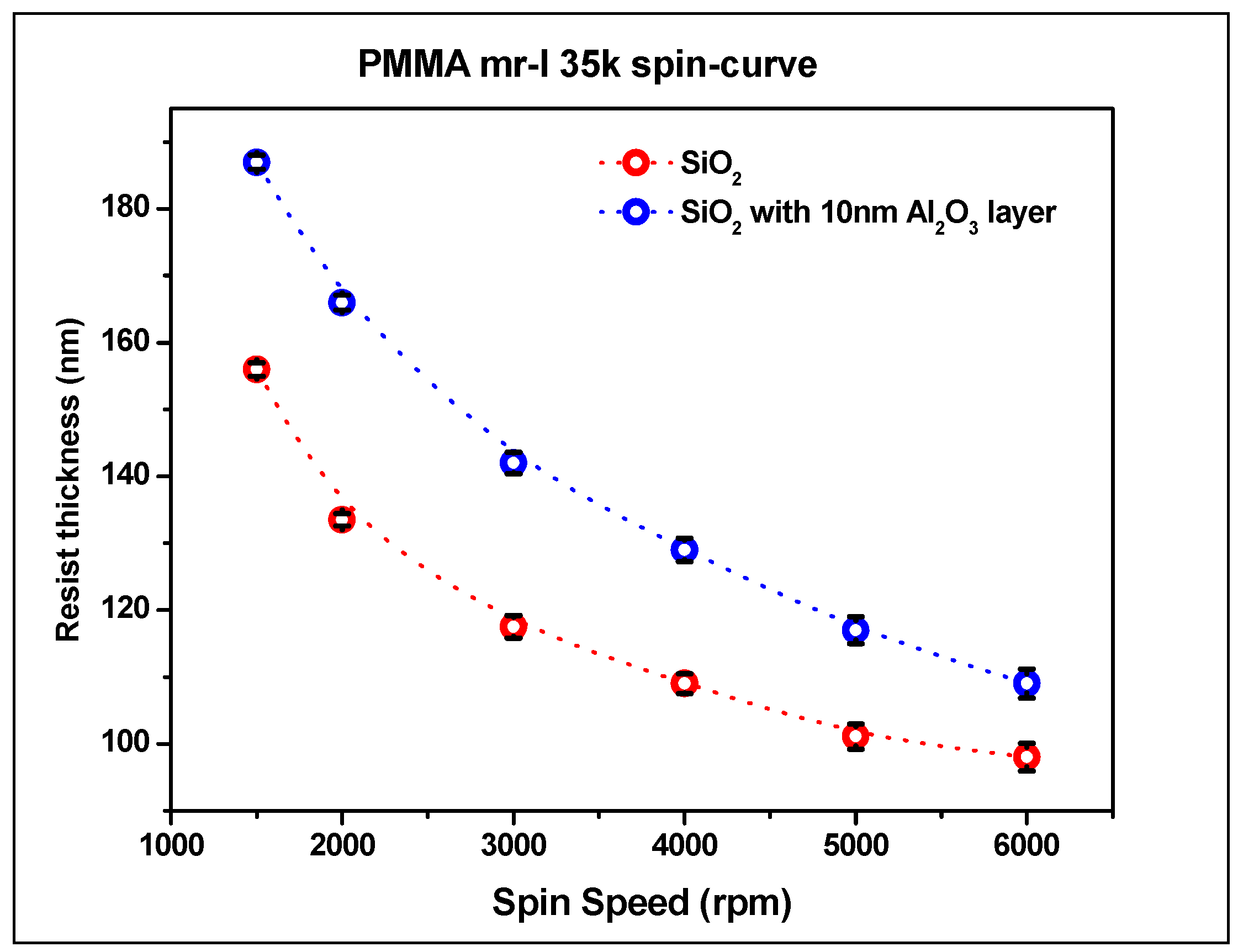
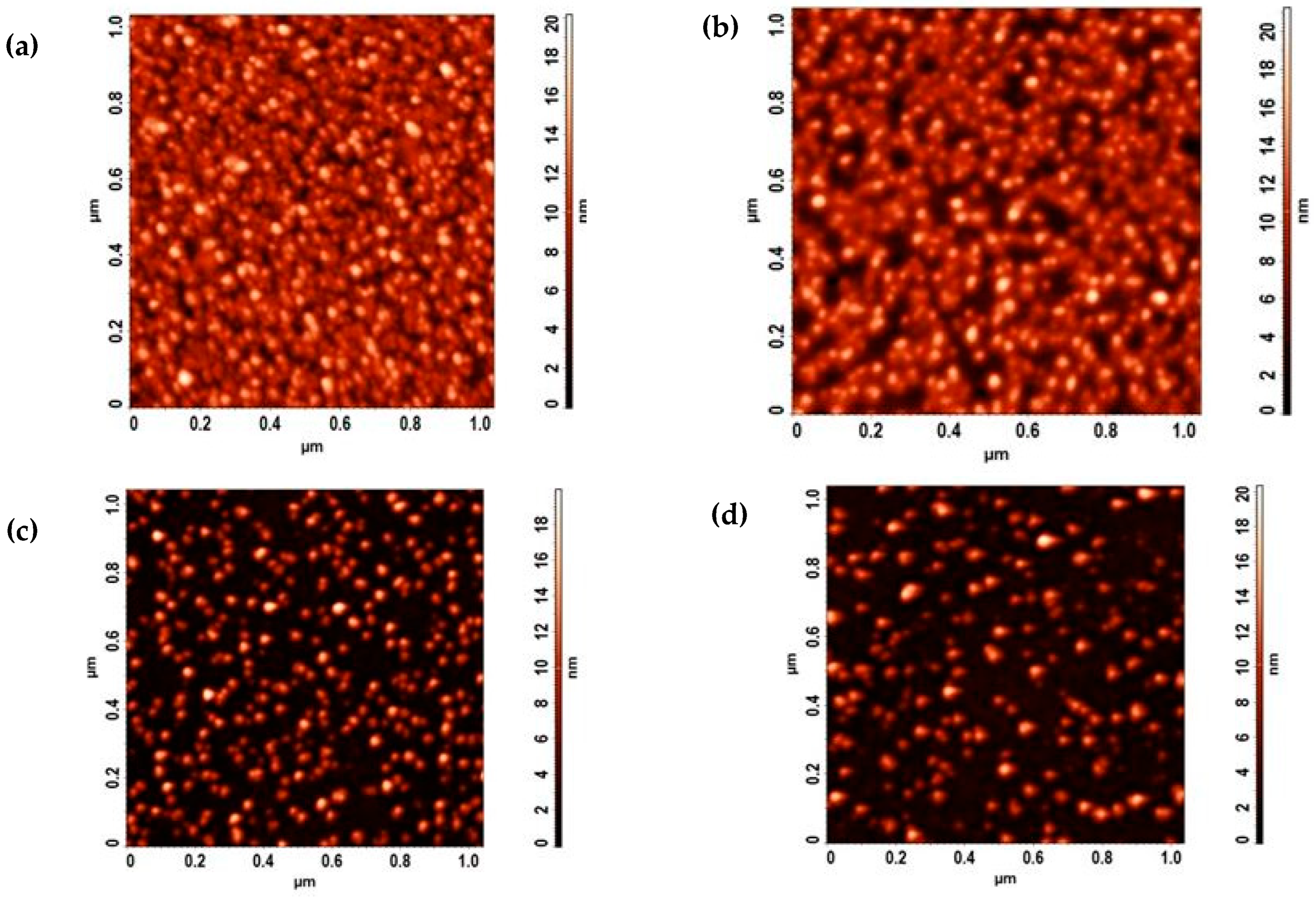

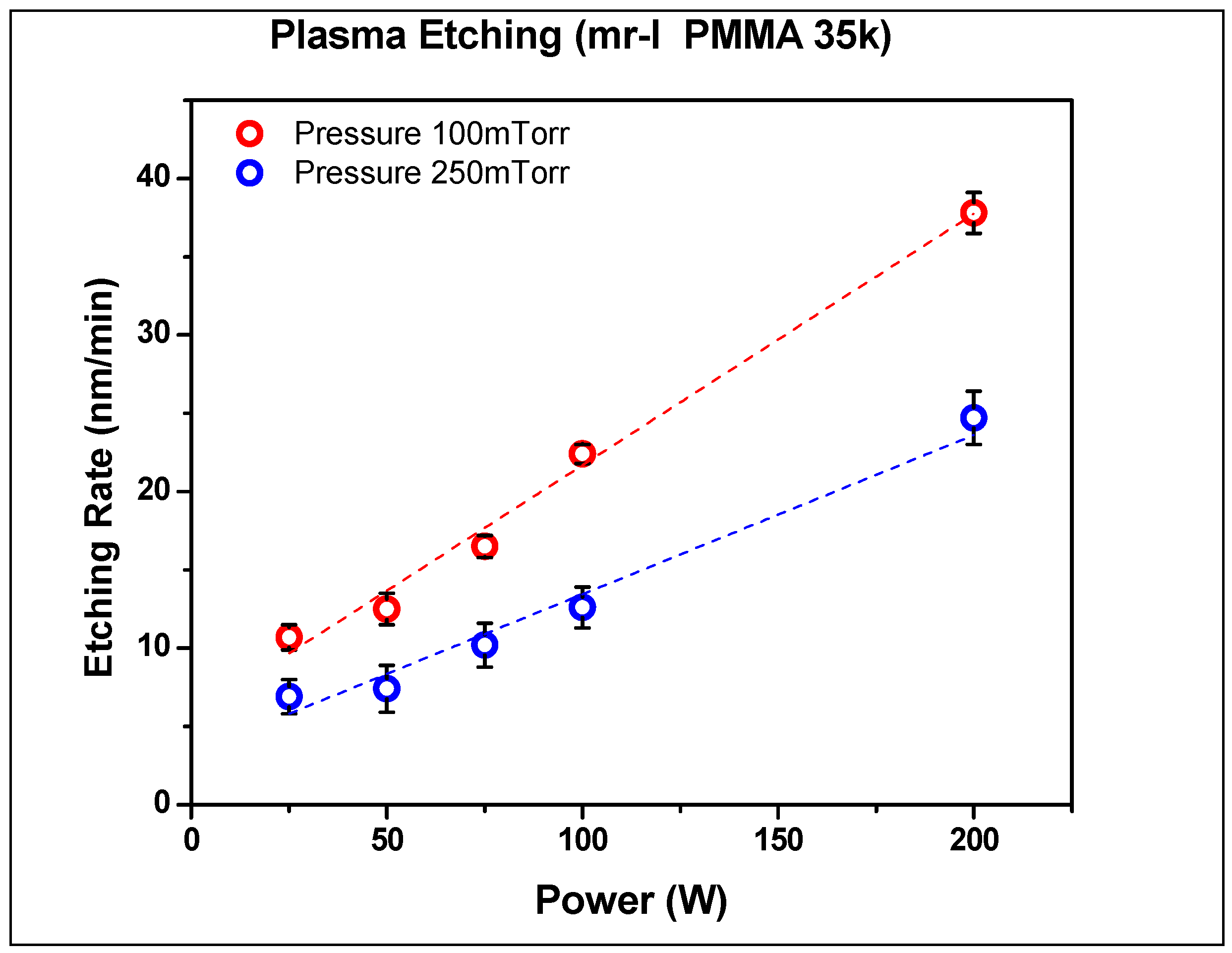
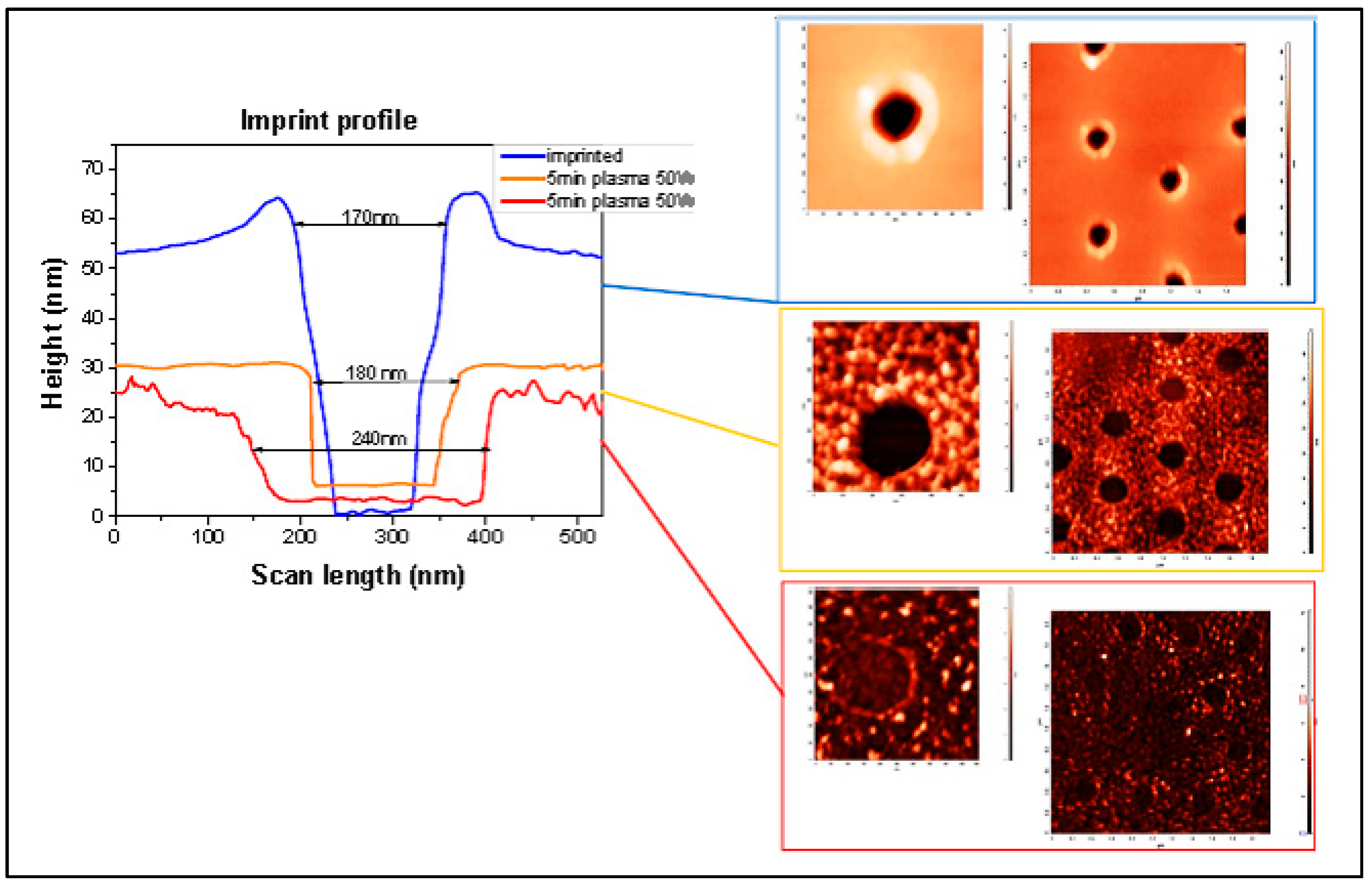





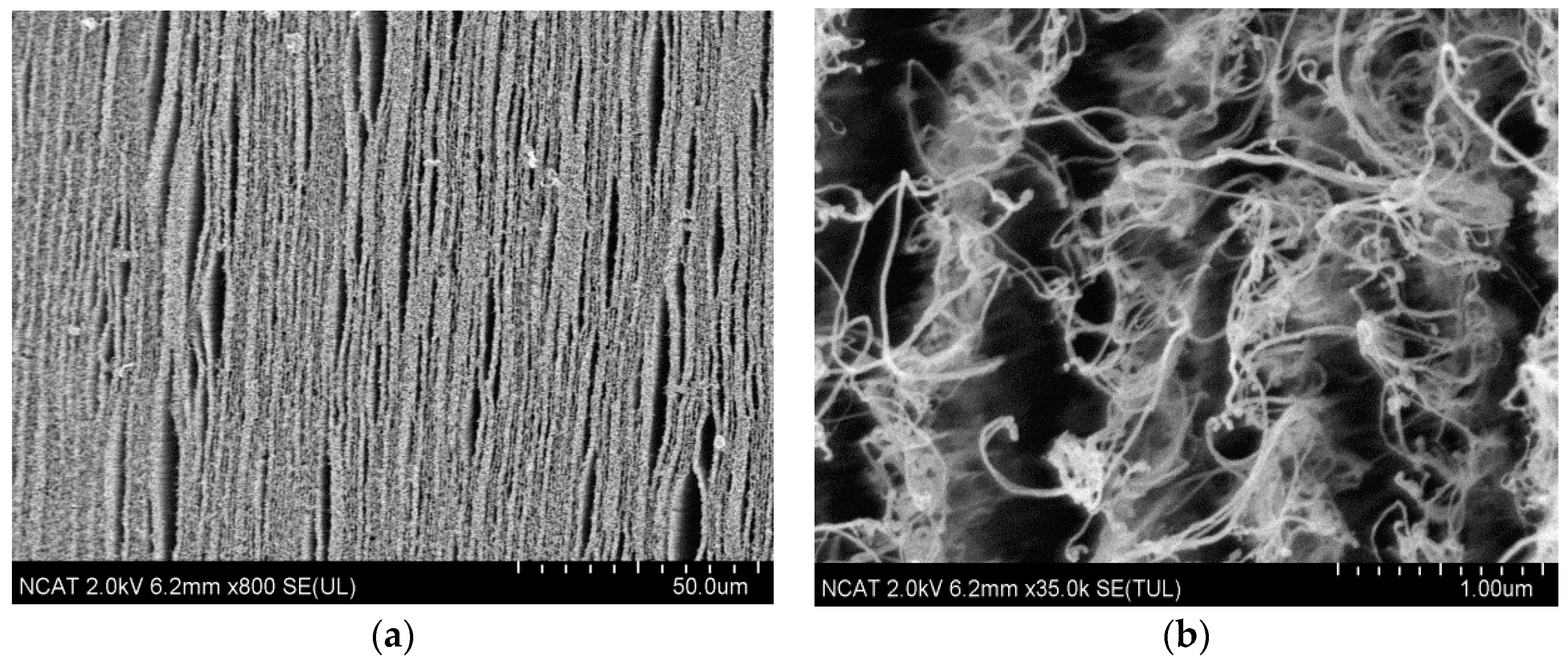

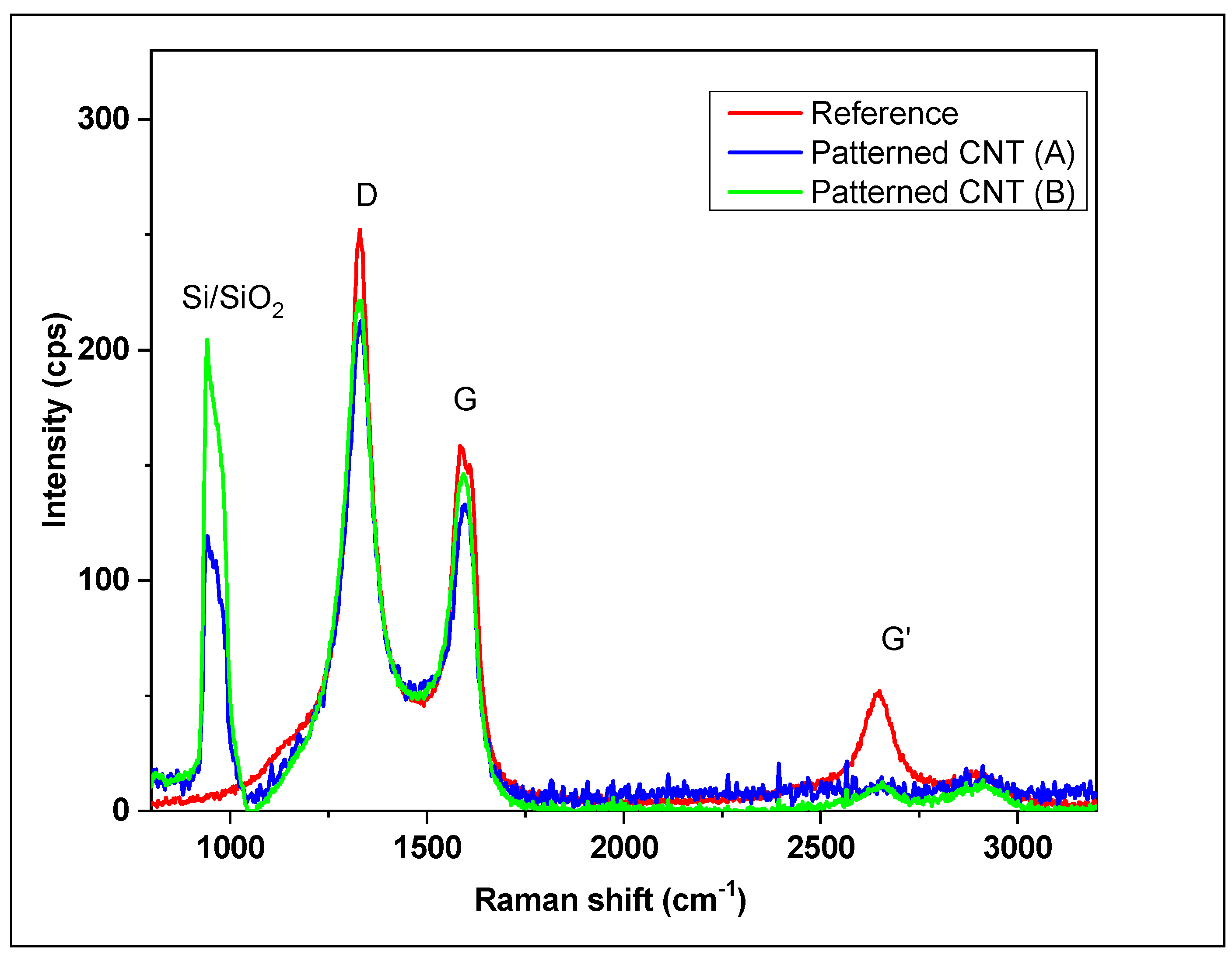
| Target | Power Source | Power(W) | Working Pressure (mTorr) | Deposition Rate (nm/min) |
|---|---|---|---|---|
| Al2O3 | RF | 100 | 1 | 2.0 |
| Al2O3 | RF | 100 | 4 | 1.8 |
| Al2O3 | RF | 250 | 1 | 6.1 |
| Al2O3 | RF | 250 | 2 | 5.5 |
| Al2O3 | RF | 250 | 4 | 5.0 |
| Al2O3 | RF | 250 | 6 | 4.6 |
| Fe | DC | 100 | 1 | 4.8 |
| Fe | DC | 100 | 4 | 4.5 |
| Co | DC | 100 | 1 | 5.2 |
| Co | DC | 100 | 4 | 4.9 |
| CNT Type | D (cm−1) | G (cm−1) | G′ (cm−1) | ID/IG Ratio |
|---|---|---|---|---|
| Reference MWCNT | 1329 | 1594 | 2643 | 1.36 |
| Patterned CNT (A) | 1328 | 1594 | 2656 | 1.42 |
| Patterned CNT (B) | 1327 | 1592 | 2648 | 1.43 |
Disclaimer/Publisher’s Note: The statements, opinions and data contained in all publications are solely those of the individual author(s) and contributor(s) and not of MDPI and/or the editor(s). MDPI and/or the editor(s) disclaim responsibility for any injury to people or property resulting from any ideas, methods, instructions or products referred to in the content. |
© 2024 by the authors. Licensee MDPI, Basel, Switzerland. This article is an open access article distributed under the terms and conditions of the Creative Commons Attribution (CC BY) license (https://creativecommons.org/licenses/by/4.0/).
Share and Cite
Fialkova, S.; Yarmolenko, S.; Krishnaswamy, A.; Sankar, J.; Shanov, V.; Schulz, M.J.; Desai, S. Nanoimprint Lithography for Next-Generation Carbon Nanotube-Based Devices. Nanomaterials 2024, 14, 1011. https://doi.org/10.3390/nano14121011
Fialkova S, Yarmolenko S, Krishnaswamy A, Sankar J, Shanov V, Schulz MJ, Desai S. Nanoimprint Lithography for Next-Generation Carbon Nanotube-Based Devices. Nanomaterials. 2024; 14(12):1011. https://doi.org/10.3390/nano14121011
Chicago/Turabian StyleFialkova, Svitlana, Sergey Yarmolenko, Arvind Krishnaswamy, Jagannathan Sankar, Vesselin Shanov, Mark J. Schulz, and Salil Desai. 2024. "Nanoimprint Lithography for Next-Generation Carbon Nanotube-Based Devices" Nanomaterials 14, no. 12: 1011. https://doi.org/10.3390/nano14121011






